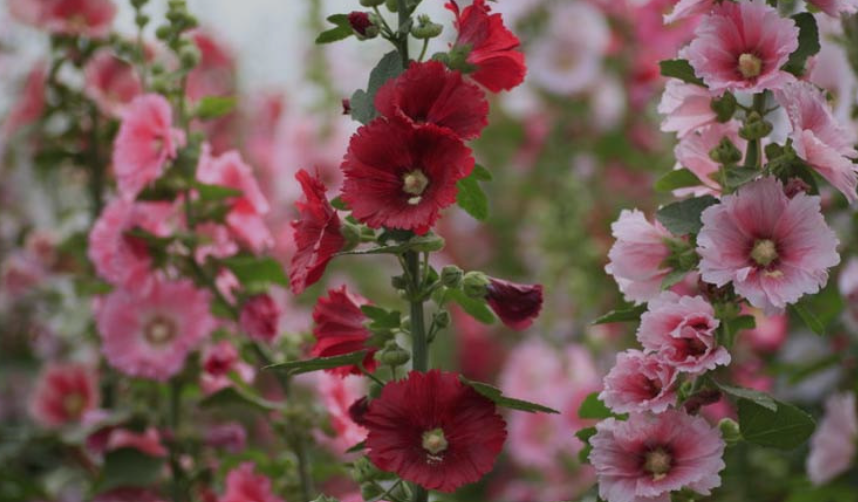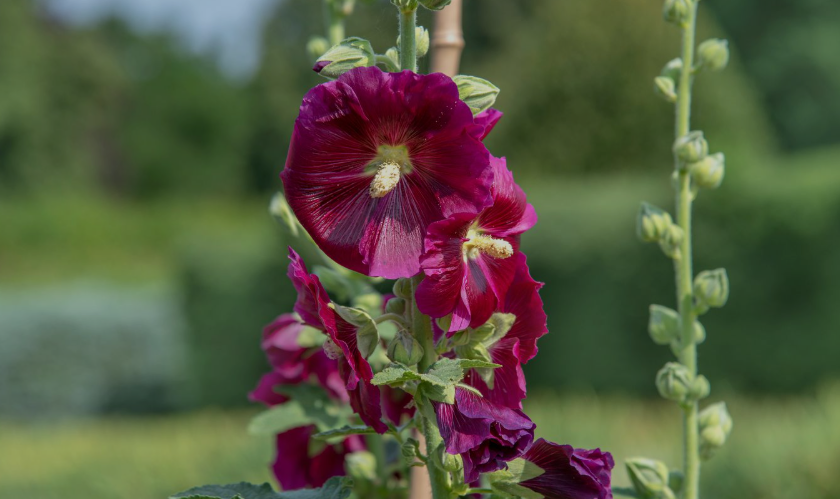
Hollyhocks are classic cottage garden favorites, loved for their tall, dramatic spires covered in colorful, saucer-shaped blooms. With their old-fashioned charm and impressive height, these flowering plants add vertical beauty to fences, walls, and borders. Native to Asia and Europe, hollyhocks belong to the Alcea genus and are closely related to hibiscus and mallows.
Despite their regal appearance, hollyhocks are surprisingly easy to grow. They reward gardeners with stunning summer blooms in shades of pink, red, yellow, white, purple, and nearly black. Here’s how to grow and care for these beautiful biennial or short-lived perennial plants.
Choosing the Right Variety
Hollyhocks come in many varieties, differing in color, size, and flower form. Some popular choices include:
- Alcea rosea ‘Nigra’ – Deep maroon, almost black flowers; dramatic and elegant.
- Alcea rosea ‘Chater’s Double’ – Full, ruffled double blooms in a range of colors.
- Alcea ficifolia (Fig-leaf Hollyhock) – More perennial and disease-resistant, with yellow to pink shades.
- Alcea rosea ‘Halo Series’ – Large single blooms with contrasting centers.
Choose varieties suited to your garden design—singles for a natural look or doubles for a lush, decorative display.
Ideal Growing Conditions
Hollyhocks thrive best in full sun and well-drained, fertile soil. These tall plants love warmth and open space where air can circulate freely.
Site selection tips:
- Pick a sunny spot receiving at least 6 hours of direct sunlight daily.
- Protect from strong winds by planting near a fence, wall, or trellis.
- Soil should be rich, slightly moist, and well-drained. Add compost before planting to boost fertility.
Planting Hollyhocks
You can grow hollyhocks either from seeds or young nursery plants.
From Seeds:
- Sow seeds outdoors in late spring or early summer for blooms the following year (hollyhocks are usually biennials).
- Plant seeds about ¼ inch deep in the soil.
- Space them 18–24 inches apart to give room for growth and airflow.
- Keep the soil evenly moist until seedlings establish.
From Transplants:
- Plant in spring once the frost has passed.
- Water well after planting and mulch lightly around the base.
Watering and Feeding

Hollyhocks prefer consistent moisture, especially during the growing and blooming season.
- Water: Deeply once a week, keeping the soil moist but not soggy. Avoid overhead watering to prevent fungal diseases.
- Mulch: Apply organic mulch to retain moisture and suppress weeds.
- Fertilizer: Feed with a balanced, slow-release fertilizer or compost in early spring and again midseason to encourage abundant blooms.
Avoid excessive nitrogen, as it promotes leaves at the expense of flowers.
Staking and Support
Because hollyhocks can grow up to 6–8 feet tall, they often need support to stay upright.
- Use bamboo stakes or garden canes, securing stems loosely with soft ties.
- Alternatively, grow them against a fence or wall for natural support.
This prevents the plants from toppling over in wind or rain.
Pruning and Deadheading
Regular maintenance keeps hollyhocks looking tidy and healthy.
- Deadhead spent blooms to extend the flowering season.
- After blooming, cut back flower stalks to the base to encourage new growth.
- If you wish the plants to self-seed, leave some seed pods to dry naturally on the stalks before collecting or allowing them to fall to the ground.
Dealing with Pests and Diseases
The most common problem with hollyhocks is rust, a fungal disease that causes orange-brown spots on leaves.
To prevent and control rust:
- Ensure good air circulation between plants.
- Water at the base, not from above.
- Remove and discard infected leaves immediately.
- Apply a fungicide if rust persists.
Other pests include aphids and spider mites—both can be managed with insecticidal soap or neem oil.
Overwintering and Longevity
Although hollyhocks are usually biennials (flowering in their second year), many varieties self-seed freely, creating a continuous display each summer. In milder climates, some act as short-lived perennials and can bloom for several years.
To help them survive winter:
- Cut plants back to a few inches above ground after the first frost.
- Apply a layer of mulch to protect roots from freezing.
In spring, remove the mulch and feed with compost to promote fresh growth.
Propagation
Hollyhocks reproduce easily from seeds or root divisions.
- Collect seeds once pods turn brown and papery.
- Store them in a cool, dry place and sow next spring.
- For root division, dig up clumps in early spring and replant offsets immediately.
Self-seeding is the simplest way to maintain a yearly display.
Design and Landscape Uses
Hollyhocks are perfect for cottage gardens, rural landscapes, and traditional flower borders.
- Plant them at the back of garden beds to create a tall, colorful backdrop.
- Combine with delphiniums, foxgloves, or daisies for a charming old-world mix.
- They also look stunning along fences, walls, and gates, where their towering spikes can shine.
Their long stems and vivid colors make excellent cut flowers, adding vintage flair to arrangements.
Final Thoughts
Growing hollyhocks is a simple way to bring timeless beauty to your garden. With their tall spires and bold blooms, they evoke nostalgia and charm, turning any space into a classic floral retreat.
By giving them full sun, rich soil, and basic care, you’ll enjoy their showy blossoms every summer. Even though they may live only a few years, hollyhocks’ habit of self-seeding ensures their delightful presence in your garden season after season.